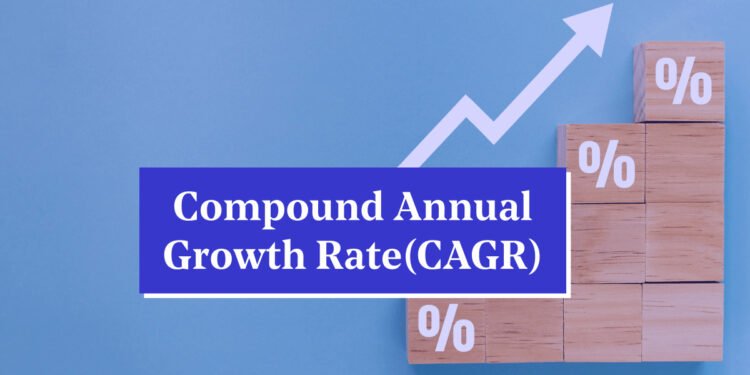In the intricate world of finance, comparing different investment options can be quite challenging. One of the pivotal tools that investors use to understand and evaluate the performance of various investments is the Compound Annual Growth Rate, or CAGR. This mechanism succinctly captures the annual rate of return of an investment over a defined period of time. Understanding CAGR is essential for both novice and experienced investors, especially those looking to delve into mutual funds and other financial assets.
What is CAGR?
CAGR, or Compound Annual Growth Rate, is a useful financial metric that expresses the annual growth rate of an investment, assuming the profits were reinvested at the end of each period. CAGR allows investors to smooth out the inconsistent returns that they may receive over various years and provides a single average rate of return.
The formula to calculate CAGR is:
“`plaintext
CAGR = (Ending Value / Beginning Value)^(1 / Number of Years) – 1
“`
For example, if you invested INR 1,00,000 in a mutual fund five years ago and your investment grew to INR 1,50,000 by the end of the period, the CAGR would be computed as follows:
“`plaintext
-CAGR = (1,50,000 / 1,00,000)^(1 / 5) – 1
CAGR = (1.5)^(0.2) – 1
CAGR ~ 0.08447 or 8.447%
“`
Thus, the annual growth rate of the investment over the five-year period is approximately 8.447%.
Why is CAGR Important?
CAGR is indispensable for various reasons:
1. Simplified Comparison: It provides a single rate of return, making it easier to compare different investment options with varied performances.
2. Eliminates Volatility: It irons out the volatility and provides a smoothed annual growth rate, offering a clearer picture of performance over time.
3. Benchmarking: Investors can use CAGR to benchmark against average market returns or other investment vehicles, thereby assessing the efficacy and efficiency of their chosen investments.
CAGR in Mutual Funds
CAGR in mutual funds is particularly significant because mutual funds typically have varying returns due to market fluctuations. When evaluating mutual funds, investors often look at the CAGR to understand how consistently the funds have performed over time.
For instance, suppose an investor is comparing two mutual funds:
– Fund A: An initial investment of INR 2,00,000 grows to INR 3,00,000 in 4 years.
– Fund B: An initial investment of INR 1,50,000 grows to INR 2,10,000 in 4 years.
The CAGR for Fund A is calculated as:
“`plaintext
-CAGR(A) = (3,00,000 / 2,00,000)^(1 / 4) – 1
CAGR(A) = (1.5)^(0.25) – 1
CAGR(A) ~ 0.1067 or 10.67%
“`
And for Fund B:
“`plaintext
-CAGR(B) = (2,10,000 / 1,50,000)^(1 / 4) – 1
CAGR(B) = (1.4)^(0.25) – 1
CAGR(B) ~ 0.0866 or 8.66%
“`
Comparing the CAGRs, Fund A has a higher annual growth rate of 10.67%, while Fund B has a CAGR of 8.66%. This suggests that Fund A performed better in terms of annual growth over the same period.
Applications of CAGR
1. Investment Portfolios: Investors can use CAGR to track the growth of their entire investment portfolio over the years.
2. Growth Forecasting: Businesses use CAGR for forecasting future growth and making strategic decisions.
3. Comparative Analysis: It helps to compare the historical performance of stocks, mutual funds, real estate, and other investment vehicles.
Limitations of CAGR
Despite its advantages, there are certain limitations to CAGR:
1. Ignores Volatility: By providing a smoothed rate, CAGR can sometimes mask the underlying volatility experienced during the investment period.
2. Excludes External Factors: Factors such as additional investments, withdrawals, or market conditions are not captured by CAGR.
3. Past Performance is Not Indicative of Future Results: While CAGR offers historical insight, it cannot predict future performance.
Conclusion
In summary, CAGR is an indispensable tool that helps investors to gauge the performance of different investment options. By providing a simplified annual growth rate, it allows for easy comparison and assessment of investment efficacy. However, while CAGR is a valuable indicator, investors must also consider other factors such as market volatility, economic conditions, and intrinsic risk associated with different investment vehicles.
Disclaimer: The content provided herein is for informational purposes only and should not be construed as financial advice. Investors must thoroughly assess all the pros and cons of trading in the Indian financial market and may consider consulting a financial advisor to make well-informed investment decisions.
Summary
The role of CAGR (Compound Annual Growth Rate) in comparing different investment options is pivotal for discerning investors. By offering a smoothed annual growth rate, CAGR simplifies the comparison of complex investment instruments, including mutual funds. The primary advantage of CAGR is its ability to eradicate volatility and provide a concise growth rate. For instance, an investment that grows from INR 1,00,000 to INR 1,50,000 over five years showcases a CAGR of approximately 8.447%. Additionally, when applied to mutual funds, such as comparing funds with CAGR rates of 10.67% and 8.66%, it becomes clear which fund performed better over a period. Despite its usefulness, it is vital to remember that CAGR does not account for market volatility or other external factors. Prospective investors must weigh these considerations to make judicious financial decisions. Disclaimer: Investors must evaluate all the pros and cons of trading in the Indian financial market.






